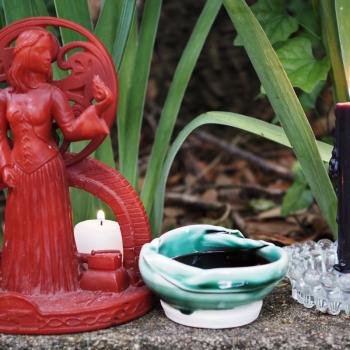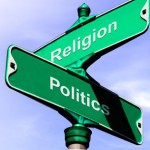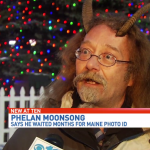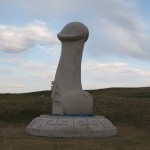In my last post, I wrote that Neo paganismwas a distinguishable tradition from Wicca, and one that is in some ways at odds with the esotericism in which Wicca is rooted. In spite of that fact, through a series of historical accidents, the two are now almost entirely intertwined. The way this happened is interesting.
The history of the interaction of Wicca and Neopaganism can be described in three stages. First, British Traditional Wicca lost control of its brand when it was imported to the United States. Gradually, traditional Wicca was transformed into an Americanized “Neo-Wicca”, which was heavily influenced by feminism, environmentalism, the Sixties Counterculture, Jungian psychology, and Robert Graves’ mythology — the same things which were also influencing non-Wiccan American Neopaganism.
Second, this Neo-Wicca came to be conflated with Neopaganism, in part due to the actions of Ed Fitch and Oberon Zell, which will be described below. Neo-Wicca then began to function as a Pan-Pagan tradition which was spread through Neopagan publications like the Green Egg and at Neopagan festivals and through CUUPS. This Pan-Pagan tradition became so ubiquitous that many Pagans and non-Pagans alike began to think it as synonymous with Neopaganism and its Wiccan origins became obscured.
Third, this process was accelerated, ironically, by the insistence of some traditional Wiccans that the application of the term “Wiccan” be limited to those who are initiated into a traditional coven. As a result, many non-initiated Neo-Wiccans began calling themselves “Pagan” or “Neopagan”, although their beliefs and practices were in fact more Wiccan than not. This further obscured the influence of Wicca on Neopaganism.
Stage 1: From British Traditional Wicca to Neo-Wicca
In the 1970’s, the number of Wiccan traditions in the U.S. began multiplying. Most of these were derived, at least in part, from British Traditional Wicca. I have identified at least 19 different Wiccan traditions which were created in the U.S. and Canada between 1969 and 1979. And those are just the ones that left a record. While some of these perceived themselves as being “traditional” (as opposed to eclectic), each one helped to change Wicca from its original form in British Traditional Wicca.
Obviously two of the most important influences on the transformation of traditional Wicca into Neo-Wicca were the feminist spirituality/Goddess movement, which manifested as feminist witchcraft, and the environmental movement, which helped transform Wicca from a mystery religion into a nature religion. Two other, often overlooked influences on Neo-Wicca were Robert Graves and Carl Jung. I could write a great deal about the influence of these two, but for present purposes, I will just hit the highlights.
Robert Graves was a significant influence on Doreen Valiente, Robert Cochrane, the Farrars, Fred Adams, Z. Budapest, Aidan Kelly, Starhawk, and Ed Fitch, and many others. Graves, not Gerald Gardner, is the source for the mythology that is associated with the Neopagan festivals today. In traditional Wiccan mythology, the god is associated with darkness and winter, and the goddess with light and summer. In Graves’ mythos, however, the goddess and her consort, each have different aspects in different stations of the year; no one gender is associated exclusively with one eason or one psychological type. It was Graves’ mythology, not Gardner’s, which was adopted by Neo-Wiccans. In addition, Graves is responsible for the Triple Goddess motif which is so common in Neo-Wicca. The Triple Goddess is not present in any early traditional Wiccan writings and does not occupy an important place in any of the writings of Gerald Gardner or his American ambassador, Raymond Buckland.
Jung was an important influence on Starhawk and on Margot Adler. The latter is the granddaughter of Alfred Adler, who together with Jung and Freud, founded the psychoanalytical movement. Adler consistently turns to Jungian theory to defend Neo-Wicca in her book, Drawing Down the Moon. This book, while ostensibly descriptive, also came to have an important prescriptive effect on the development of Neo-Wicca. The influence of Jung can readily be seen in the writings of the Farrars and of Vivianne Crowley, herself a Jungian therapist. Wouter Hanegraaf has written that Crowley’s Jungian perspective “is so strong that readers might be forgiven for concluding that Wicca is little more than a religious and ritual translation of Jungian psychology.” A good discussion of the influence of Jung on the Neo-Wiccan and Neopagan movements can be found in David Waldron’s Sign of the Witch: Modernity and the Pagan Revival and in this essay by David and Sharn Waldron.
Stage 2: From Neo-Wicca to Neopaganism: The Pagan Way
I have described above how traditional Wicca was transformed into Neo-Wicca through the influence of Robert Graves’ mythology and Jungian psychology, in addition to the feminist and environmental movements. These same influences gave birth to non-Wiccan forms of Neopaganism around the same time, including Feraferia and the Church of All Worlds. What remains to be shown is how Neo-Wicca became conflated with non-Wiccan Neopaganism. At the heart of this part of the story is the Pagan Way.
Ed Fitch was Gardnerian Wiccan. In 1969, Fitch, together with Joseph Wilson and others, began circulating Fitch’s Pagan Way materials, which began as a “outer court” training system for prospective Wiccan initiates, but quickly grew into a “celebratory” tradition of its own. These materials were first circulated informally by mailing houses and were later published in Herman Slater’s A Book of Pagan Rituals (without attribution). The Pagan Way is important to this discussion because of how it led to the confusion of essentially Wiccan practices with Paganism generally. This was encouraged by Fitch’s choice of the name “The Pagan Way” and the title of Slater’s book, A Book of Pagan Rituals.
Enter Oberon Zell, the founder of the Church of All Worlds. Zell is one of the most influential people in the history of Neopaganism, largely because of his publication of the Green Egg newsletter, which was the most important Neopagan forum from 1968 to 1976. The publication was instrumental in the formation of an emerging identity around the name “Neopagan”. In fact, Margot Adler credits Zell with popularizing the term “Neopagan” to describe the growing movement. Zell was an unabashed eclectic. This was reflected not only in his polyamous lifestyle, but also in his religious associations. He describes his working group in 1978 as including representatives of the Anderson Feri tradition, Z. Budapest’s feminist Dianic witchcraft, Morgan McFarland Dianic tradition, NROOGD, the Mohsian tradition, and several others — all of which were eclectic traditions to begin with. In short, Zell was not the type of person to draw sharp distinctions.
The critical moment occurred when Zell, who was, as has been said, articulating for the first time what Neopaganism was, adopts Ed Fitch’s Pagan Way materials — not as a Neo-Wiccan liturgy, but as a Neo-Pagan liturgy. In one fell swoop, Neo-Wicca was forever conflated with Neopaganism. Because of Zell’s defining role in the formation of a Neopagan identity, and because of the reach of his ideas through the Green Egg, this conflation became the reality for the entire movement. And as far as I can tell, this happened as early as 1970. Ed Fitch’s choice of a single word and Zell’s undiscriminating eclecticism defined the course of Neopaganism for decades.
The Neopagan festival culture, which began in 1974, helped to further consolidate Neo-Wicca as the sine qua non of Neopaganism. Wiccan terminology and rituals forms became a lingua franca for Neopagan festivals. Another phenomena which accelerated the spread of the Neo-Wicca was the organization of the Covenant of Unitarian Universalist Pagans (CUUPS) in 1985. Just as in the case of Pagan festivals, in spite of the nominally non-denominational nature of CUUPS Paganism, the ritual forms adopted by CUUPS chapters are predominately Neo-Wiccan.
Stage 3: What’s in a Wiccan Name?
While “Witch” was the preferred term in the 1960’s, in the 1970’s, the term “Wicca” began to increase and came to be applied to all Neopagan Witchcraft. Part of the reason for the increasing popularity of the term “Wicca” may have been the desire (conscious or not) to disassociate Neo-Wicca from the image of the witch in the popular mind. This was part of a gradual movement in Neopaganism away from the radical feminist image of the witch to the more respectable image of Wicca as a nature or “earth-centered” religion. According to Ross Nichols, the name “Wicca”:
“offered a fresh, uncontaminated name, one that could not be confused with either contemporary Satanism or with alleged medieval Devil worship. It was clean, life affirming, youthful, and by the 1990s, almost fashionable among young adults seeking alternative lifestyles.”
However, in the 1990’s, there was a backlash against the “Wiccan” appellation. Ironically, this only helped to obscure the influence of Neo-Wicca on Neopaganism. The backlash against “Wicca” was due in part to the increasing popularization of Neo-Wicca. Around 1985, the use of the term “Wicca” in published works began to increase, peaking around 2003. The number “Wicca 101” books grew exponentially. In 1996, the movie The Craft was released. In 1997 and 1998, the television series Buffy the Vampire Slayer and Charmed aired, both featuring Neo-Wiccan characters. These and other popular movies, television series, and books have been credited with bringing many adolescents into Wicca, as well as a “watering down” of Wicca to make it more acceptable to the general public.
In 2001, the term “fluffy” (later “fluffybunny”) was coined by the author of the Internet essay, “Why Wiccans Suck”. The epithet “fluffy” came to be applied to portrayals of Wicca that have been watered down to make it palatable for mass or teen consumption. The article was an example of a growing animus toward the “Wicca” appellation by those who did not seem to appreciate the pervasiveness of the Neo-Wiccan influence on Neopaganism. The debunking of the Wiccan origin myth by Aidan Kelly in 1991 and Ronald Hutton in 1999 only helped to make “Wicca” less popular among Neopagans.
This created the ironic situation of many Neopagans who had adopted Neo-Wiccan ritual practices and theology simultaneously trying to disassociate themselves from “Wicca”. As noted above, the phenomenon was actually encouraged by those traditionalists who insisted that one must be initiated into a coven to be “Wiccan”. That left a Neo-Wiccan with only the terms “Witch” and “Pagan” to describe themselves, even if their practice was largely derived from Wicca. Thus “Witch” and “Pagan” came to be synonymous with practices and beliefs which were Wiccan in everything but name. This is how a couple of self-described “Witches” at my UU congregation could organize a Beltane celebration where they cleanse the space with a besom broom, cast a circle, invoke the four elemental quarters, invoke the Lord and Lady … and then proclaim that they are not “Wiccan” and have, in fact, never met a “Wiccan”.
Conclusion
Where does this leave us? First, the bell has been rung. British Traditional Wicca will never regain its control over the term “Wicca”, which now has largely come to mean an Americanized Neo-Wicca. Second, Neo-Wicca and Neopaganism have become so conflated that the Wiccan influence on supposedly non-denominational or Pan-Pagan rituals is pervasive, but largely invisible to many. This has now led some to try to disassociate themselves from the term “Paganism” as well.
Now, you might wonder why I have put so much effort into detailing the line between Wicca and Neopaganism and trying to distinguish the two — I know I have wondered the same thing. This series of posts is not intended to be a “Why Wiccans Suck” essay. Nevertheless, the fact is that Wiccan practices and beliefs do not resonate with, largely because of the influence of esotericism. But there is a constellation of beliefs and practices which I do resonate with, and for which, for the life of me, I cannot come up with any better name than “Neopagan”.
Imagine for a moment that you lived your whole life without hearing of Christianity. And then you pick up a Bible and you read the gospels and you are converted. You decide you are a Christian — before ever having met a Christian. Now imagine that you go in search of the Christian community and (since this is an alternate reality) you discover that the Christianity that has become mainstream is Gnosticism. While it bears some superficial resemblances to what you read about in the Bible, it seems quite different and even antithetical to what you understood Christianity to be.
That’s how I felt when I discovered the Neopagan community. I felt like this great religious idea I had discovered had been infected by something quite foreign — esotericism — just as Gnosticism was seen by some as an infection of Christianity by Neoplatonism. In the same way that Gnosticism introduced an anti-materialism into Christianity, so I feel that esotericism, through Wicca, introduces an anti-materialism into Neopaganism. In my next post, I want to talk about three groups that have tried to take the esotericism out of Neopaganism: (1) Gaia Group, (2) TOTEG, and (3) naturalistic/humanistic paganism.















